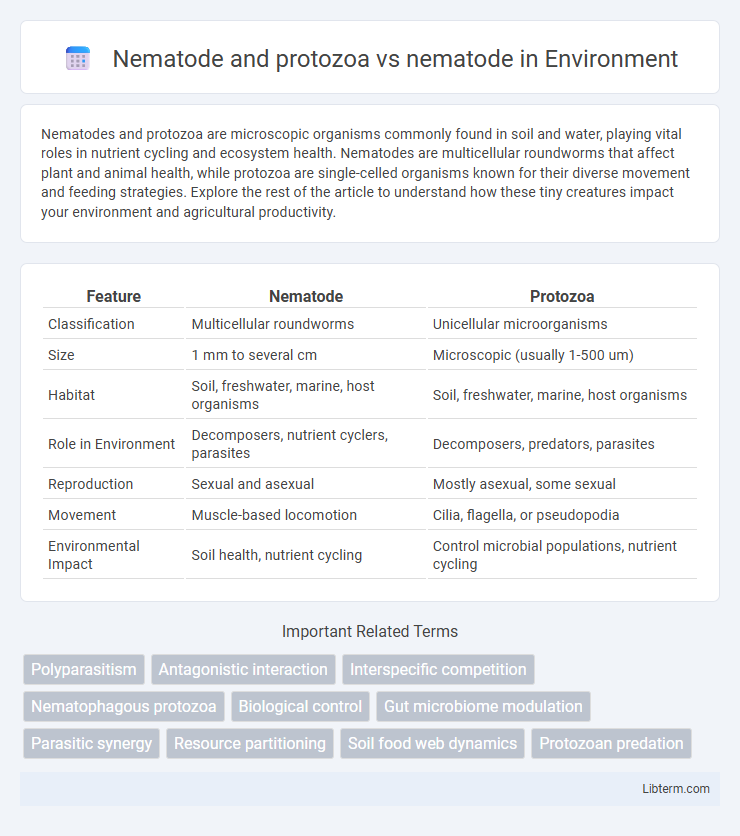Nematodes and protozoa are microscopic organisms commonly found in soil and water, playing vital roles in nutrient cycling and ecosystem health. Nematodes are multicellular roundworms that affect plant and animal health, while protozoa are single-celled organisms known for their diverse movement and feeding strategies. Explore the rest of the article to understand how these tiny creatures impact your environment and agricultural productivity.
Table of Comparison
| Feature | Nematode | Protozoa |
|---|---|---|
| Classification | Multicellular roundworms | Unicellular microorganisms |
| Size | 1 mm to several cm | Microscopic (usually 1-500 um) |
| Habitat | Soil, freshwater, marine, host organisms | Soil, freshwater, marine, host organisms |
| Role in Environment | Decomposers, nutrient cyclers, parasites | Decomposers, predators, parasites |
| Reproduction | Sexual and asexual | Mostly asexual, some sexual |
| Movement | Muscle-based locomotion | Cilia, flagella, or pseudopodia |
| Environmental Impact | Soil health, nutrient cycling | Control microbial populations, nutrient cycling |
Introduction to Nematodes and Protozoa
Nematodes and protozoa are microscopic organisms found ubiquitously in soil and aquatic environments, playing crucial roles in nutrient cycling and ecosystem dynamics. Nematodes are elongated, cylindrical worms classified as multicellular animals, while protozoa are single-celled eukaryotes exhibiting diverse morphological forms and modes of locomotion. Both groups contribute to controlling microbial populations, but nematodes primarily consume bacteria and fungi, whereas protozoa feed on bacteria and smaller protozoans, highlighting their complementary ecological functions.
Key Differences Between Nematodes and Protozoa
Nematodes are multicellular roundworms with a complete digestive system, while protozoa are unicellular eukaryotes that often exhibit motility through cilia or flagella. Nematodes possess a defined body structure with tissue differentiation, contrasting with the single-celled, often microscopic nature of protozoa. Ecologically, nematodes play roles as parasites or decomposers in soil ecosystems, whereas protozoa typically act as free-living predators or parasites in aquatic environments.
Overview of Nematode Characteristics
Nematodes, also known as roundworms, exhibit a cylindrical, elongated body structure with a complete digestive system and a tough outer cuticle that is periodically molted. Unlike protozoa, which are unicellular and often motile through cilia or flagella, nematodes are multicellular organisms with a well-developed nervous and reproductive system. Nematodes inhabit diverse environments including soil, freshwater, and marine ecosystems, where they play crucial roles in nutrient cycling and as parasites affecting plants, animals, and humans.
Structure and Function of Protozoa
Protozoa are unicellular eukaryotic organisms with complex cell structures including a nucleus, mitochondria, and specialized organelles for movement such as cilia or flagella, enabling motility and feeding. Their flexible pellicle allows shape variation, facilitating phagocytosis and nutrient intake, whereas nematodes are multicellular with a rigid exoskeleton and a more defined organ system for digestion, reproduction, and locomotion. Protozoa perform essential ecological roles in nutrient cycling by decomposing organic matter and serving as primary consumers in aquatic food webs.
Ecological Roles: Nematode and Protozoa Interactions
Nematodes and protozoa play crucial ecological roles in soil ecosystems, with nematodes primarily contributing to nutrient cycling by decomposing organic matter, while protozoa regulate bacterial populations through predation. Interactions between nematodes and protozoa influence soil microbial community dynamics, affecting soil fertility and plant health. Their combined activity enhances nutrient availability by promoting a balanced microbial food web and accelerating mineralization processes.
Nematode vs. Protozoa: Life Cycle Comparison
Nematodes, multicellular roundworms, exhibit complex life cycles involving egg, larval, and adult stages, often requiring multiple hosts or environments for development. Protozoa, unicellular organisms, undergo simpler life cycles typically characterized by binary fission, cyst formation, and sometimes sexual reproduction through conjugation. The contrast in life cycle complexity reflects their structural differences, with nematodes demonstrating higher developmental stages and protozoa adapting to rapid reproduction and survival in variable conditions.
Disease Associations: Nematodes vs Protozoa
Nematodes cause diseases such as ascariasis, hookworm infection, and lymphatic filariasis, impacting the intestines, lymphatic system, and tissues. Protozoa are responsible for diseases like malaria, amoebiasis, and giardiasis, affecting the bloodstream, intestines, and various organs. Both groups contribute to significant global health burdens but differ in transmission modes and pathogenic mechanisms.
Nematode-only Systems: Unique Features
Nematode-only systems exhibit unique features such as a simple, tubular digestive system with a complete gut from mouth to anus, facilitating efficient nutrient absorption and waste elimination. These systems rely on a pseudocoelom for hydrostatic skeleton support, enabling precise locomotion and body flexibility distinct from protozoa's single-celled organization. The presence of a protective cuticle and specialized sensory organs in nematodes allows adaptation to diverse environments, setting them apart from protozoa, which lack such multicellular structural complexity.
Nematode and Protozoa in Soil Health
Nematodes and protozoa are crucial biological indicators of soil health, each contributing to nutrient cycling and soil structure maintenance. Nematodes regulate microbial populations by feeding on bacteria, fungi, and other soil organisms, enhancing nutrient mineralization and promoting plant growth. Protozoa consume bacteria, releasing nitrogen in plant-available forms, thus sustaining soil fertility and improving overall soil ecosystem functionality.
Future Research: Nematode and Protozoa Synergy
Future research on nematode and protozoa synergy emphasizes exploring their interdependent roles in soil ecosystems and nutrient cycling. Understanding molecular interactions and signaling pathways between nematodes and protozoa can uncover novel mechanisms for biocontrol and sustainable agriculture. Advanced genomic and metagenomic tools are pivotal in elucidating the complex dynamics that drive nematode-protozoa synergistic effects on plant health and soil fertility.
Nematode and protozoa Infographic

 libterm.com
libterm.com